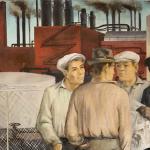Lost Mural by Secret Communist Unearthed in Richmond Basement

The Richmond Museum of History is a one-room gallery, housed in an old brick library. Just two part-time staff keep the doors open. One of them is Melinda McCrary, the museum’s director.
“I do everything,” says McCrary, shutting off the hose in the front garden. “I take out the trash. I’m the main fundraiser. I do all the programming.”
When McCrary came on board in 2014, she got to chatting with a long-time Richmond resident who asked, “‘Have you heard of this post office mural that has been lost?'”
He told her that the artist Victor Arnautoff — a protégé of Diego Rivera, and the lead artist for the murals inside the lobby of Coit Tower — had painted a beautiful mural on a canvas the size of the side of a U-Haul trailer.
For 35 years, it was displayed over the postmaster’s window at Richmond’s main post office.
But the mural was taken down during a renovation in 1976. “It was just forgotten,” says McCrary. “It just got lost in the shuffle.”
She decided she had to find it.
A snapshot of Richmond before the war
Arnautoff painted his mural in 1941, just months before the U.S. entered World War II, and Richmond transformed into an epicenter for wartime ship building.
Historian Robert Cherny, an emeritus professor at San Francisco State University (SFSU), says Arnautoff followed a process he used for other post office murals in the New Deal era: He started by talking to locals.
“Arnautoff talked to the local postmaster, the local newspaper editor,” Cherny says. “He walked around the streets.”
The Richmond captured on canvas is a quiet town on its way to becoming an industrial city. There’s a woman in a yellow dress, buying fruit. There’s a boy with his bicycle. In the background, a freight train passes by oil tanks and a refinery spouting black smoke.
Arnautoff, who at that time was a secret member of the Communist party, dropped subtle political messages into his mural. He depicts four dock workers on their (union-guaranteed) lunch break, discussing the news of the day.
Catherine Powell, director of the Labor Archives and Research Center at SFSU noticed that two of the workers have round pins on their hats, indicating membership of the longshoremen’s union.
And one of the four is black — a significant gesture at a time when African-Americans made up just 1% of the city’s population.
Cherny says the local longshoremen’s union was one of the first to promote an a racially integrated workforce. The union “stood for the equality of all of its workers,” Cherny says.
Into the basement
When McCrary asked postal employees about the mural, they hadn’t heard of it, and they wouldn’t let her conduct a search for the long lost work around their building.
So she asked a member of her board to help — a former city council member who happened to know Richmond’s former postmaster. The former postmaster knew a janitor who worked at the post office. And the janitor agreed to look for the mural.
One day, after the post office closed, the janitor let McCrary into the basement.
“It was totally sneaky,” McCrary says. “I was not supposed to be down there.”
Deep underground, he opened a pair of double doors to a small dusty room. There was only one thing in the room: a large, wooden crate with a handwritten label that said “Victor Arnotoff” .
McCrary couldn’t verify that the mural was in the box, let alone run off with it. She had to spend a year persuading the postal service to approve a loan to her museum.
Then, just weeks after the deal was signed, McCrary found out that the basement of the post office was flooded.
She panicked, and rushed to the post office basement with a couple of art handlers. There, they saw a waterline six inches from the bottom of the crate.
“We were all convinced that the mural was ruined,” McCrary says.
They whisked the crate out of the post office, pried it open with a crowbar, and discovered that the mural had been stored on a set of stilts.
“It was an absolutely exhilarating feeling to know that it didn’t get wet,” McCrary says.
A life-size reproduction of the mural is now on exhibit at SFSU.
McCrary is trying to raise funds to restore the original painting. Nathan Zakheim, the same art preservationist who took down the mural in 1976, may be the one to restore it.
McCrary hopes to display the restored original at the Richmond Museum of History, located just a few blocks away from the post office. “I want to put the Richmond museum on the map,” McCrary says.
For now, the mural is wrapped up in plastic at the museum — in a basement.
Victor Arnautoff and the Politics of Art runs through Tuesday, Dec. 12 at the Labor Archives and Research Center at San Francisco State University.
Eli Wirtschafter is a freelance reporter and producer focusing on transportation, art, and activism. He previously interned with The California Report and KQED Local News. Eli is also KALW's transportation reporter, and a graduate of KALW's Audio Academy. Eli's work has been heard on NPR, Here & Now, and BackStory. Find him on Twitter at @RadioEli.
